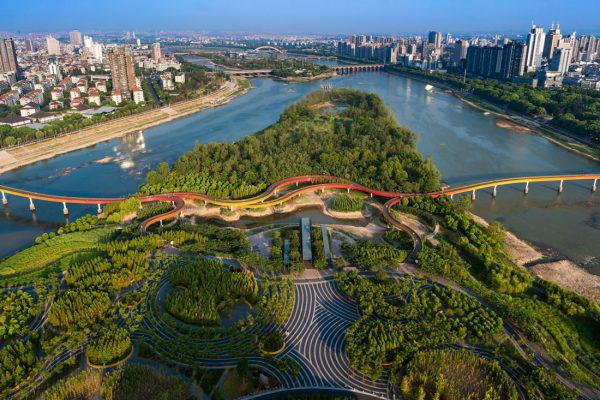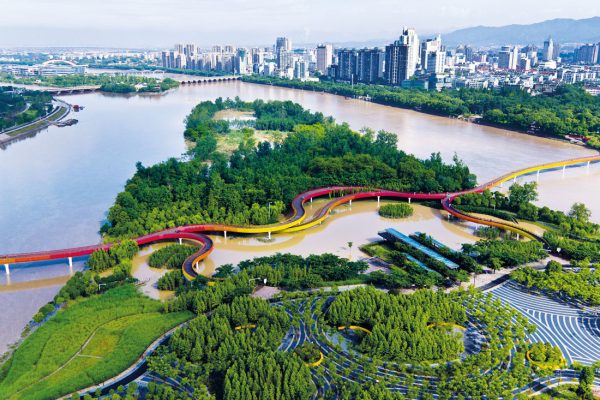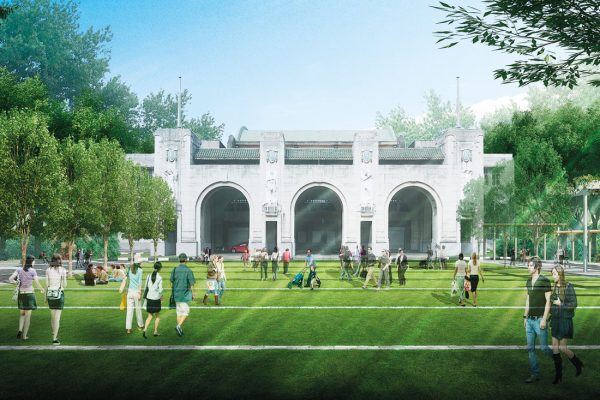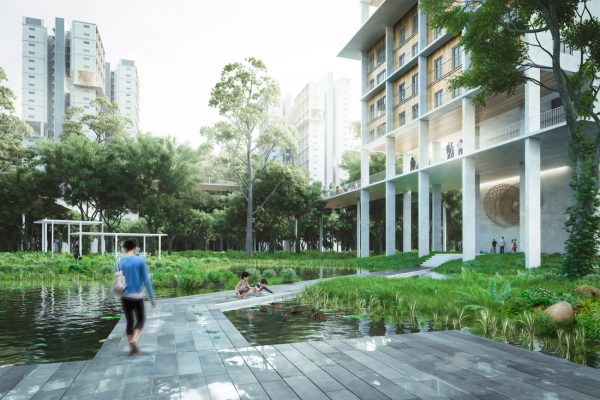Dr Yu Kongjian, the founder of multi-disciplinary design and engineering firm Turenscape, is a leader in the development of landscapes that combat flooding while repairing ecological damage and winning hearts.

Dr Yu Kongjian photographed in his workzone at Turenscape's Beijing Headquarters. Portrait by Shawn Koh
July 31st, 2018
In Asia’s rush towards urbanisation, a post-industrial framework of water management has largely been adopted. It is characterised by draining water away from our cities as quickly as possible, using pipes and concrete drains.
Dr Yu Kongjian, founder and Principal Designer of Turenscape and Dean of the College of Architecture and Landscape Architecture at Peking University, presents the idea of Sponge Cities – a concept synthesising modern water management systems with the ancient Chinese agricultural wisdom deployed in rice paddies and ponds.

Yanweizhou Park during dry season. Photo by Dr Yu Kongjian, courtesy of Turenscape.
Sponge Cities retain and slow down the flow of water through the use of terraces, ponds and dykes. Urban landscapes become active systems that absorb excess water during monsoon rains, retain and filter it within a meandering landscape, and release it for use during dry seasons.

Yanweizhou Park during wet season. Photo by Dr Yu Kongjian, courtesy of Turenscape.
The Sponge City solution to urban inundation has been applied in over two hundred cities in China and beyond, gaining credence as the Chinese government’s adopted urban ecology framework.
Water-scarce Singapore certainly has reason to take a leaf or two out of Turenscape’s book.
Retaining water is thus a key national policy issue – a familiar refrain in Singapore.
When asked for his thoughts on Singapore’s ecological development, Dr Yu raises several pertinent points. “Singapore has built so much, all its rivers are channelised. Ramboll Atelier Dreiseitl did a great job with Bishan-Ang Mo Kio Park, but you have 100 more canals to deal with,” he jests.
“There is strong bureaucracy and an established infrastructural framework – but if you can integrate an ecological mindset into the civil engineering system, Singapore can become a sponge nation, reach its goal of being self-sustainable, and solve the problem of floods,” he adds.
Singapore will soon see an initial test bed of some of Dr Yu’s strategies, as Turenscape was awarded noteworthy Rail Corridor commissions for the adaptive reuse of Tanjong Pagar Station and integrated housing at Choa Chu Kang with MKPL Architects.

The exterior of the former Tanjong Pagar Railway Corridor with MKPL Architects. Rendering by Norm Li for Turenscape/MKPL team.
Their proposals involve transforming the linear corridor into a social nexus that retains cultural heritage as well as ecological flows through the site.

The exterior wetlands of the integrated housing at Cho Chu Kang project with MKPL Architects. Rendering by Norm Li for Turenscape/MKPL team.
Read the complete article in Cubes 91: Designing Resilience.
A searchable and comprehensive guide for specifying leading products and their suppliers
Keep up to date with the latest and greatest from our industry BFF's!

Sub-Zero and Wolf’s prestigious Kitchen Design Contest (KDC) has celebrated the very best in kitchen innovation and aesthetics for three decades now. Recognising premier kitchen design professionals from around the globe, the KDC facilitates innovation, style and functionality that pushes boundaries.

Savage Design’s approach to understanding the relationship between design concepts and user experience, particularly with metalwork, transcends traditional boundaries, blending timeless craftsmanship with digital innovation to create enduring elegance in objects, furnishings, and door furniture.

The Sub-Zero Wolf showrooms in Sydney and Melbourne provide a creative experience unlike any other. Now showcasing all-new product ranges, the showrooms present a unique perspective on the future of kitchens, homes and lifestyles.

In the pursuit of an uplifting synergy between the inner world and the surrounding environment, internationally acclaimed Interior Architect and Designer Lorena Gaxiola transform the vibration of the auspicious number ‘8’ into mesmerising artistry alongside the Feltex design team, brought to you by GH Commercial.
The internet never sleeps! Here's the stuff you might have missed

Landing in the city’s financial district for the first time, The Sebel Sydney Martin Place has had its modern interiors completed by Stack Studio.

Available now across Australia, Eden TPO is setting new standards in terms of not just sustainability, but also style.

In our series spotlighting aficionados across the design industry, we spoke with Alexandra Guglielmino, who leads the Art Advisory team at Bluethumb Art Gallery.

Overcoming pandemic hurdles to redefine guest experiences amidst Sydney’s bustling entertainment precinct, The Darling has undergone a two-year restoration that melds Art Deco interiors with the necessities of hotel living.